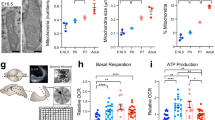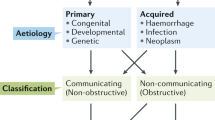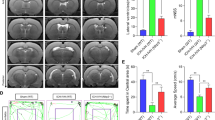Abstract
The choroid plexus epithelium (CPE) secretes higher volumes of fluid (cerebrospinal fluid, CSF) than any other epithelium and simultaneously functions as the blood–CSF barrier to gate immune cell entry into the central nervous system1. Posthemorrhagic hydrocephalus (PHH), an expansion of the cerebral ventricles due to CSF accumulation following intraventricular hemorrhage (IVH), is a common disease usually treated by suboptimal CSF shunting techniques2. PHH is classically attributed to primary impairments in CSF reabsorption, but little experimental evidence supports this concept. In contrast, the potential contribution of CSF secretion to PHH has received little attention. In a rat model of PHH, we demonstrate that IVH causes a Toll-like receptor 4 (TLR4)- and NF-κB-dependent inflammatory response in the CPE that is associated with a ∼3-fold increase in bumetanide-sensitive CSF secretion. IVH-induced hypersecretion of CSF is mediated by TLR4-dependent activation of the Ste20-type stress kinase SPAK, which binds, phosphorylates, and stimulates the NKCC1 co-transporter at the CPE apical membrane. Genetic depletion of TLR4 or SPAK normalizes hyperactive CSF secretion rates and reduces PHH symptoms, as does treatment with drugs that antagonize TLR4–NF-κB signaling or the SPAK–NKCC1 co-transporter complex. These data uncover a previously unrecognized contribution of CSF hypersecretion to the pathogenesis of PHH, demonstrate a new role for TLRs in regulation of the internal brain milieu, and identify a kinase-regulated mechanism of CSF secretion that could be targeted by repurposed US Food and Drug Administration (FDA)-approved drugs to treat hydrocephalus.
This is a preview of subscription content, access via your institution
Access options
Access Nature and 54 other Nature Portfolio journals
Get Nature+, our best-value online-access subscription
$29.99 / 30 days
cancel any time
Subscribe to this journal
Receive 12 print issues and online access
$209.00 per year
only $17.42 per issue
Buy this article
- Purchase on Springer Link
- Instant access to full article PDF
Prices may be subject to local taxes which are calculated during checkout



Similar content being viewed by others

References
Lun, M.P., Monuki, E.S. & Lehtinen, M.K. Development and functions of the choroid plexus–cerebrospinal fluid system. Nat. Rev. Neurosci. 16, 445–457 (2015).
Kahle, K.T., Kulkarni, A.V., Limbrick, D.D. Jr. & Warf, B.C. Hydrocephalus in children. Lancet 387, 788–799 (2016).
McAllister, J.P. II et al. An update on research priorities in hydrocephalus: overview of the third National Institutes of Health–sponsored symposium “Opportunities for Hydrocephalus Research: Pathways to Better Outcomes”. J. Neurosurg. 123, 1427–1438 (2015).
Chen, Q. et al. Post-hemorrhagic hydrocephalus: recent advances and new therapeutic insights. J. Neurol. Sci. 375, 220–230 (2017).
Karimy, J.K. et al. Cerebrospinal fluid hypersecretion in pediatric hydrocephalus. Neurosurg. Focus 41, E10 (2016).
Gram, M. et al. Extracellular hemoglobin—mediator of inflammation and cell death in the choroid plexus following preterm intraventricular hemorrhage. J. Neuroinflammation 11, 200 (2014).
Gao, C. et al. Role of red blood cell lysis and iron in hydrocephalus after intraventricular hemorrhage. J. Cereb. Blood Flow Metab. 34, 1070–1075 (2014).
Berkes, J., Viswanathan, V.K., Savkovic, S.D. & Hecht, G. Intestinal epithelial responses to enteric pathogens: effects on the tight junction barrier, ion transport, and inflammation. Gut 52, 439–451 (2003).
Wilson, R. et al. Upper respiratory tract viral infection and mucociliary clearance. Eur. J. Respir. Dis. 70, 272–279 (1987).
Doyle, W.J. et al. Nasal and otologic effects of experimental influenza A virus infection. Ann. Otol. Rhinol. Laryngol. 103, 59–69 (1994).
Kotas, M.E. & Medzhitov, R. Homeostasis, inflammation, and disease susceptibility. Cell 160, 816–827 (2015).
Nowarski, R., Jackson, R. & Flavell, R.A. The stromal intervention: regulation of immunity and inflammation at the epithelial–mesenchymal barrier. Cell 168, 362–375 (2017).
Sin, B. & Togias, A. Pathophysiology of allergic and nonallergic rhinitis. Proc. Am. Thorac. Soc. 8, 106–114 (2011).
Thiagarajah, J.R., Donowitz, M. & Verkman, A.S. Secretory diarrhoea: mechanisms and emerging therapies. Nat. Rev. Gastroenterol. Hepatol. 12, 446–457 (2015).
Simard, P.F. et al. Inflammation of the choroid plexus and ependymal layer of the ventricle following intraventricular hemorrhage. Transl. Stroke Res. 2, 227–231 (2011).
Liu, S.F., Ye, X. & Malik, A.B. Inhibition of NF-κB activation by pyrrolidine dithiocarbamate prevents in vivo expression of proinflammatory genes. Circulation 100, 1330–1337 (1999).
Karimy, J.K. et al. A novel method to study cerebrospinal fluid dynamics in rats. J. Neurosci. Methods 241, 78–84 (2015).
Damkier, H.H., Brown, P.D. & Praetorius, J. Cerebrospinal fluid secretion by the choroid plexus. Physiol. Rev. 93, 1847–1892 (2013).
Vitari, A.C. et al. Functional interactions of the SPAK/OSR1 kinases with their upstream activator WNK1 and downstream substrate NKCC1. Biochem. J. 397, 223–231 (2006).
Gagnon, K.B. & Delpire, E. Molecular physiology of SPAK and OSR1: two Ste20-related protein kinases regulating ion transport. Physiol. Rev. 92, 1577–1617 (2012).
Piechotta, K., Garbarini, N., England, R. & Delpire, E. Characterization of the interaction of the stress kinase SPAK with the Na+–K+–2Cl− cotransporter in the nervous system: evidence for a scaffolding role of the kinase. J. Biol. Chem. 278, 52848–52856 (2003).
Yan, Y. et al. Nuclear factor-κB is a critical mediator of Ste20-like proline-/alanine-rich kinase regulation in intestinal inflammation. Am. J. Pathol. 173, 1013–1028 (2008).
de Los Heros, P. et al. The WNK-regulated SPAK/OSR1 kinases directly phosphorylate and inhibit the K+–Cl− co-transporters. Biochem. J. 458, 559–573 (2014).
Kikuchi, E. et al. Discovery of novel SPAK inhibitors that block WNK kinase signaling to cation chloride transporters. J. Am. Soc. Nephrol. 26, 1525–1536 (2015).
Medzhitov, R. TLR-mediated innate immune recognition. Semin. Immunol. 19, 1–2 (2007).
Miyake, K. Innate immune sensing of pathogens and danger signals by cell surface Toll-like receptors. Semin. Immunol. 19, 3–10 (2007).
Skipor, J., Szczepkowska, A., Kowalewska, M., Herman, A.P. & Lisiewski, P. Profile of Toll-like receptor mRNA expression in the choroid plexus in adult ewes. Acta Vet. Hung. 63, 69–78 (2015).
Kawamoto, T., Ii, M., Kitazaki, T., Iizawa, Y. & Kimura, H. TAK-242 selectively suppresses Toll-like receptor 4-signaling mediated by the intracellular domain. Eur. J. Pharmacol. 584, 40–48 (2008).
Alessi, D.R. et al. The WNK–SPAK/OSR1 pathway: master regulator of cation–chloride cotransporters. Sci. Signal. 7, re3 (2014).
Piechotta, K., Lu, J. & Delpire, E. Cation chloride cotransporters interact with the stress-related kinases Ste20-related proline-alanine-rich kinase (SPAK) and oxidative stress response 1 (OSR1). J. Biol. Chem. 277, 50812–50819 (2002).
Yang, S.S. et al. SPAK-knockout mice manifest Gitelman syndrome and impaired vasoconstriction. J. Am. Soc. Nephrol. 21, 1868–1877 (2010).
Yan, Y., Nguyen, H., Dalmasso, G., Sitaraman, S.V. & Merlin, D. Cloning and characterization of a new intestinal inflammation-associated colonic epithelial Ste20-related protein kinase isoform. Biochim. Biophys. Acta 1769, 106–116 (2007).
Lin, S. et al. Heme activates TLR4-mediated inflammatory injury via MyD88/TRIF signaling pathway in intracerebral hemorrhage. J. Neuroinflammation 9, 46 (2012).
Kwon, M.S. et al. Methemoglobin is an endogenous Toll-like receptor 4 ligand—relevance to subarachnoid hemorrhage. Int. J. Mol. Sci. 16, 5028–5046 (2015).
Boivin, M.J., Kakooza, A.M., Warf, B.C., Davidson, L.L. & Grigorenko, E.L. Reducing neurodevelopmental disorders and disability through research and interventions. Nature 527, S155–S160 (2015).
Whitelaw, A., Kennedy, C.R. & Brion, L.P. Diuretic therapy for newborn infants with posthemorrhagic ventricular dilatation. Cochrane Database Syst. Rev. (2), CD002270 (2001).
Römermann, K. et al. Multiple blood–brain barrier transport mechanisms limit bumetanide accumulation, and therapeutic potential, in the mammalian brain. Neuropharmacology 117, 182–194 (2017).
Javaheri, S. & Wagner, K.R. Bumetanide decreases canine cerebrospinal fluid production. In vivo evidence for NaCl cotransport in the central nervous system. J. Clin. Invest. 92, 2257–2261 (1993).
Vogh, B.P. & Langham, M.R. Jr. The effect of furosemide and bumetanide on cerebrospinal fluid formation. Brain Res. 221, 171–183 (1981).
Stone, S.S. & Warf, B.C. Combined endoscopic third ventriculostomy and choroid plexus cauterization as primary treatment for infant hydrocephalus: a prospective North American series. J. Neurosurg. Pediatr. 14, 439–446 (2014).
Ferguson, C., McKay, M., Harris, R.A. & Homanics, G.E. Toll-like receptor 4 (Tlr4) knockout rats produced by transcriptional activator–like effector nuclease (TALEN)-mediated gene inactivation. Alcohol 47, 595–599 (2013).
Lodhia, K.R., Shakui, P. & Keep, R.F. Hydrocephalus in a rat model of intraventricular hemorrhage. Acta Neurochir Suppl. 96, 207–211 (2006).
Jinno, F. et al. Investigation of the unique metabolic fate of ethyl (6R)-6-[N-(2-chloro-4-fluorophenyl) sulfamoyl] cyclohex-1-ene-1-carboxylate (TAK-242) in rats and dogs using two types of 14C-labeled compounds having different labeled positions. Arzneimittelforschung 61, 458–471 (2011).
Gárate, I. et al. Toll-like 4 receptor inhibitor TAK-242 decreases neuroinflammation in rat brain frontal cortex after stress. J. Neuroinflammation 11, 8 (2014).
Feng, Y. et al. Neuroprotective effects of resatorvid against traumatic brain injury in rat: involvement of neuronal autophagy and TLR4 signaling pathway. Cell. Mol. Neurobiol. 37, 155–168 (2017).
Su, F. et al. Protective effect of ginsenosides Rg1 and Re on lipopolysaccharide-induced sepsis by competitive binding to Toll-like receptor 4. Antimicrob. Agents Chemother. 59, 5654–5663 (2015).
Nugent, B.M., Valenzuela, C.V., Simons, T.J. & McCarthy, M.M. Kinases SPAK and OSR1 are upregulated by estradiol and activate NKCC1 in the developing hypothalamus. J. Neurosci. 32, 593–598 (2012).
Acknowledgements
We thank D.R. Alessi (Dundee) and R.P. Lifton (Rockefeller) for their support. K.T.K. is supported by the March of Dimes Basil O'Connor Award, a Simons Foundation SFARI Grant, the Hydrocephalus Association Innovator Award, and the NIH (4K12NS080223-05). J.M.S. is supported by the National Institute of Neurological Disorders and Stroke (NINDS) (NS060801; NS061808) and the US Department of Veterans Affairs (1BX002889); R.M. is supported by the Howard Hughes Medical Institute.
Author information
Authors and Affiliations
Contributions
K.T.K., J.M.S., V.G., and J.K.K. conceived and designed the study. J.K.K., J.Z., D.B.K., B.C.T., and J.A.S. preformed molecular and physiological experiments, data analysis for IVH surgery, genetic and pharmacological drug treatment, CSF secretion measurement, and western blot, IHC, and ventricular volume analyses. K.T.K., J.M.S., J.Z., D.D., C.G.F., and J.K.K. drafted the manuscript and figures. X.Z., M.S.M., J.M., A.V., M.L.D., E.D., S.L.A., M.G., and R.M. provided expertise and collaboration in drafting the manuscript. All authors contributed to critical editing and data presentation within the manuscript. J.M.S. and K.T.K. are the principal investigators and are responsible for the oversight of this study.
Corresponding author
Ethics declarations
Competing interests
The authors declare no competing financial interests.
Supplementary information
Supplementary Figures
Supplementary Figures 1–4 (PDF 3093 kb)
Supplementary Data
Uncropped western blot images (PDF 1799 kb)
Rights and permissions
About this article
Cite this article
Karimy, J., Zhang, J., Kurland, D. et al. Inflammation-dependent cerebrospinal fluid hypersecretion by the choroid plexus epithelium in posthemorrhagic hydrocephalus. Nat Med 23, 997–1003 (2017). https://doi.org/10.1038/nm.4361
Received:
Accepted:
Published:
Issue Date:
DOI: https://doi.org/10.1038/nm.4361
This article is cited by
-
The genetic basis of hydrocephalus: genes, pathways, mechanisms, and global impact
Fluids and Barriers of the CNS (2024)
-
Pro-inflammatory cerebrospinal fluid profile of neonates with intraventricular hemorrhage: clinical relevance and contrast with CNS infection
Fluids and Barriers of the CNS (2024)
-
CSF hyperdynamics in rats mimicking the obesity and androgen excess characteristic of patients with idiopathic intracranial hypertension
Fluids and Barriers of the CNS (2024)
-
Polyvinylpyrrolidone-coated catheters decrease choroid plexus adhesion and improve flow/pressure performance in an in vitro model of hydrocephalus
Child's Nervous System (2024)
-
The manifestations of metabolic acidosis during acetazolamide treatment in a cohort of pediatric idiopathic intracranial hypertension
Pediatric Nephrology (2024)


